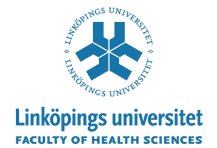 |
Visa svensk kursplan |
|
COURSE CATEGORY Single subject course MAIN FIELD OF STUDY SUBJECT AREA |
COURSE CODE | 8FA029 |
Learning outcomes
By the end of the course the students will be able to:
-Integrate the knowledge of the molecular mechanisms involved in monogenic and polygenic traits to understand the genetic basis of diseases and recognise the interplay with environmental factors
-Explain how concepts of genetic variation in populations are affecting evolution and population genetics
-Demonstrate how calculation of allele frequencies, genetic association and risks from genetic data are achieved and identify ethical problems associated with genetic analyses
-Identify strategies and explain methodological possibilities, interpret experimental results and apply computer-based methods to be able to identify disease genes
-Demonstrate the theoretical basis as well as practically explain selected molecular genetic methodology for gene identification and present, evaluate and communicate the pros and cons of these methods
-Summarise, integrate and assess scientific litterature within medical genetics
-Disease gene identification
-How environmental factors influence the genetic material and affect expression
-Genetic variation in populations and its influence on genetic predisposition, molecular/genetic epiodemiology
-Calculation of allele frequencies, associations and risk
-Principles of major molecular genetic laboratory methods and interpretation of results, hands-on knowledge of selected methodology
-Seminars on selected scientific papers
The educational method used is problem-based learning (PBL). PBL emphasises the student´s development of free, self-supporting, lifelong learning ability as an instrument for critical inquiry. The student´s own queries and the problems formulated form the basis of PBL. What is also important is the student´s ability to take responsibility for his/her own learning, and to seek and evaulate information and knowledge as well as to develop co-operative skills and a flexible attitude to different views and ideas.
Students who have failed the course or part of the course twice are entitled to request another examiner for the following examination occasion.
Extent of re-examination
The extent of a re-examination shall be similar to the regular examination.
Entries for examinations
Rules for entries for examination are given in the course plan. In addition the "Regulations regarding examinations and examiners" laid down by decision of Linköpings University (Dnr LiU 1109/00-40) apply.
Applicants with a degree from a non-Swedish university must enclose an official examination certificate of at least three years of full-time studies in subjects with relevance for Life Science, such as biology, chemistry, medicine or the like.
Documented knowledge of English equivalent to ”Engelska B”; i.e. English as native language or an internationally recognized test, e.g. TOEFL (miminum scores: Paperbased 550 + TWE-score 4.0, computerbased 213 and internetbased 79), IELTS, academic (minimum score: Overall band 6.0 and no band under 5.0), or equivalent.
Planning and implementation of the course shall be carried out on the basis of the wording in this course plan. The evaluation of the course should therefore consider the question how well the course agrees with the course plan. Oral and written evaluation will take place at the end of the course.
Electronic evaluation of the course will also take place in accordance with Linköping University´s regulations (Dnr LiU 780/06-04).
Certificate
At the student´s request, course certificate may be issued by the director of studies for courses or, according to delegation, by the head of the department/director of programme studies. Request for course certificate must be made at specific form (found at the course organiser´s or the educational office).
Additional Information
The course is given in such a way that both men´s and women´s experiences and knowledge are foregrounded and developed.
If the course is withdrawn, or is subject to major changes, examinations according to this course plan are normally offered on a total of three occasions within a year, one of them in close connection with the first examination.
|
||||||||||||||||||||||||||||||||||||||||||||||||||||||||||||||||||||||||||||||